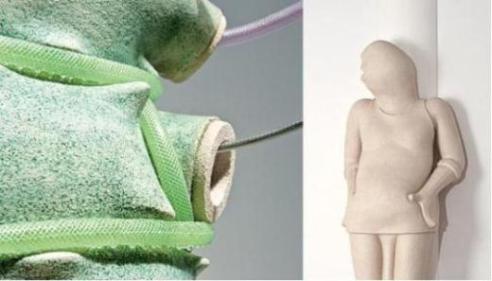
Mirko Bratuša, "Heaters for Hot Feelings" (detail), 2011. Glazed ceramics, electric heaters, installed heat pumps, electric wiring and water hoses.*
Slovenian Pavilion
54th International Art Exhibition – La Biennale di Venezia
Mirko Bratuša
Heaters for Hot Feelings
Sculpture installation
Pavilion opening: 2 June, 6.30 pm
Preview: 1–3 June 2011
4 June–30 October 2011
10 am–6 pm (Mondays closed)
Curator: Nadja Zgonik
Venue: Galleria A+A, Slovene Central for Visual Art, San Marco 3073/Calle Malipiero, Venice 30124
www.mirkobratusa.si
www.galerija-bj.si
www.aplusa.it
Mirko Bratuša's sculpture installation Heaters for Hot Feelings is composed of eight tactile, anthropo- and biomorphic pieces each of which about 2 m (7 ft.) high. Hidden electrical fittings heat, humidify and cool the fired clay sculptures. The heat generated by the cooling of the first sculptures will be used to heat the others. A network of connections is set up as a system of artificial bodies, which indicate their mutual dependence. The metaphorics of an artistic system constructed in this manner are universally applicable to modern society, in which everything happens in mutual relation: amassing wealth on one side of the planet leads to poverty on the other, exploiting nature causes natural disasters, social unrest changes political systems.
Mirko Bratuša's sculptures are captured in various states of emotion. They are fantastically expressive, designed with sculptural extravagance and refined humour. Hinting at eccentric phenomena from the western Catholic tradition, they reveal to us the exotic in the commonplace. Thus in order to achieve a higher level of empathy they are made from the decidedly expressive and no longer mass-marketed material of fired clay. They are tactile, warm and cold. They show us the psychotic aspect of our everyday lives, reflect our fears and speak of our sense of being lost in modern culture, where it seems that we can no longer affect politics and social power relations and that it is no longer possible to halt the processes of destruction of nature. Therefore, Bratuša suggests, we have to return to elementary perceptions, to the realm of lost sensibility.
Mirko Bratuša (1963) graduated in Sculpture from the Academy of Fine Arts in Ljubljana in 1989, and continued his studies at the Academy of Fine Arts in Munich with Professor Leo Kornbrust from 1990 to 1992, and in 1993 at the Academy of Arts in Düsseldorf with Professor Tony Cragg. Among his many solo exhibitions are recent presentations at Círculo de Bellas Artes, Madrid (2005); Glesia Gallery, Ljubljana (2006) and Božidar Jakac Art Museum, Kostanjevica na Krki (2010).
Mirko Bratuša is part of a generation of Slovene sculptors which appeared at the end of the eighties under the heading of New Slovene Sculpture, following the model of New British Sculpture. The internationally best-known of this generation is sculptor Marjetica Potrč, and Tobias Putrih is noteworthy among their successors (both have exhibited previously at the Slovenian Pavilion at the Venice Biennale). Mirko Bratuša stands out atypically from this generation through his whimsicality and fascination with materials. His restless experimental spirit has led him to combine "old" sculptural media such as clay, wood and bronze with new industrially produced materials such as polyurethane, kerrock, electrical fittings and cooling systems. Since 1992 he is setting sculptural installations which are often interactive and include unusual technical tricks. His works hide a touch of humour, through which he presents his figures as the ironically "bright" future of posthuman society.
www.mirkobratusa.si,
www.galerija-bj.si,
www.aplusa.it
International press contact:
Aurora Fonda
Galleria A+A
info@aplusa.it
T / F +39 041 2770466
Organizer:
Božidar Jakac Art Museum, Grajska cesta 45, 8311 Kostanjevica na Krki, Slovenia
info@galerija-bj.si, T +386 (0)7 498 8140, F +386 (0)7 498 8151, www.galerija-bj.si
*Image above:
Photo Tomaž Lunder.
Design by Matjaž Čuk.
Courtesy the Artist and Galerija Božidar Jakac, Kostanjevica na Krki.
Galerija Božidar Jakac.



